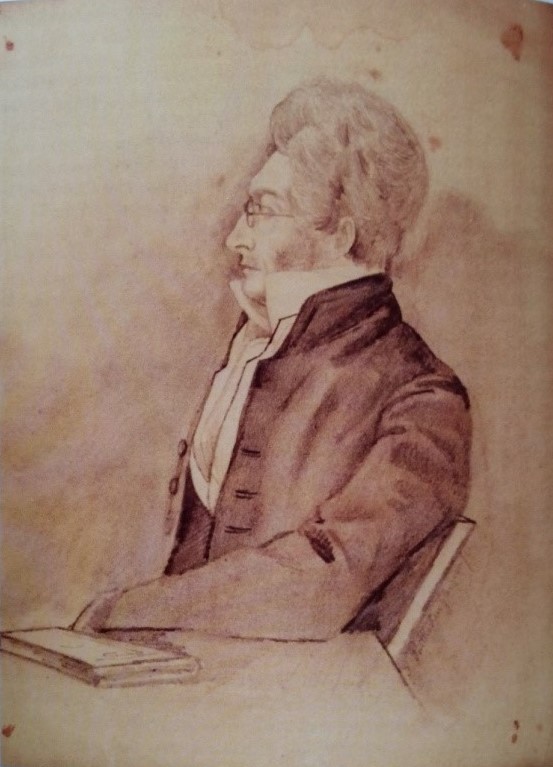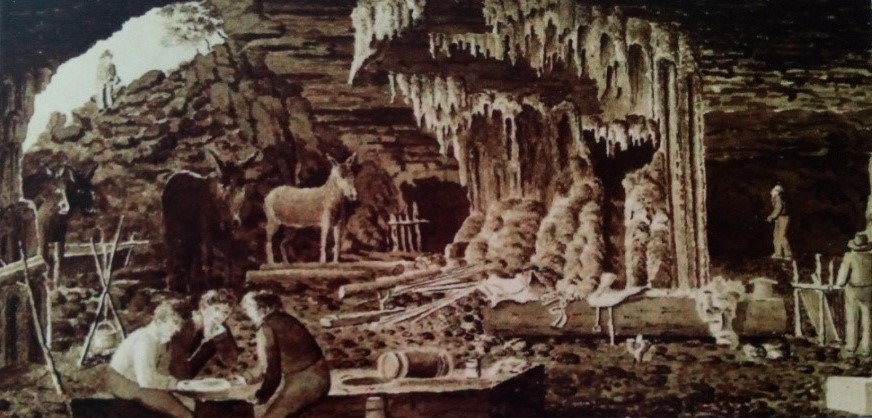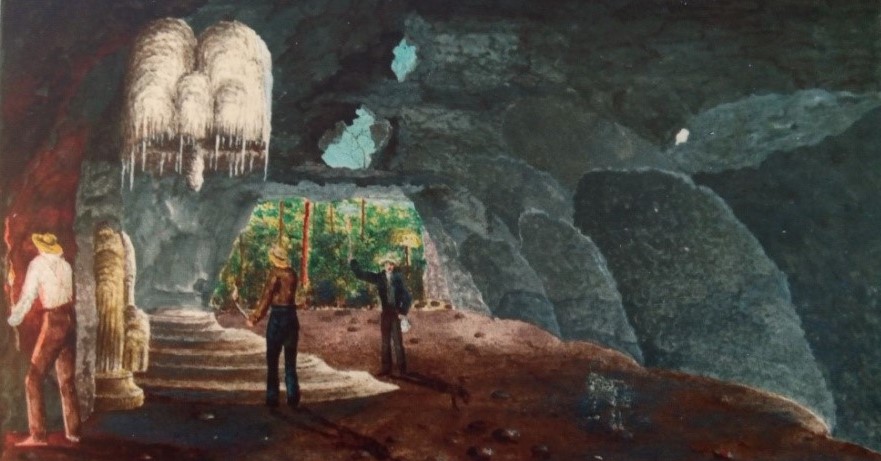Peter Wilhelm Lund
by Gesa Mackenthun, 03/01/2016.
Summary
The Danish scientist Peter Wilhelm Lund, a largely forgotten naturalist in colonial Brazil, discovered the petrified bones of human beings in a cave in Minas Gerais, mixed with the bones of extinct animals, in 1843. This led Lund to assume the extreme antiquity of the human presence in America – an antiquity that was hard to reconcile with the biblical narrative of Creation according to which the world was no older than 6000 years. Because of his peripheral position, but also because of the revolutionary quality of his find, Lund’s contribution to science did not receive the lasting attention it deserved. Lund himself discontinued his research into the bone caves shortly after this discovery, for a variety of reasons but mainly – it is assumed – because of an intellectual crisis and a shortage of funds. Lund remained in Brazil and was unjustly excluded from the annals of science. But until today he is a well-remembered local hero in Minas Gerais.
A Spectacular Discovery?
In 1843, the Danish naturalist Peter Wilhelm Lund (Fig. 1) examined an extended network of caves in Lagoa Santa in the province of Minas Gerais, Brazil, where he made a remarkable discovery.
In a geological layer that he identified as a glacial drift, he found, among the bones of extinct mammals such as the terrible sabre tooth tiger, the petrified bones of thirty human skeletons. Lund’s discovery turned his whole conception of earth time upside down. He had been a disciple of the French naturalist George Cuvier whose geological theory tried to reconcile the growing scientific knowledge about the age of the earth with the Biblical time count according to which the earth had been created on Tuesday, October 23, 4004 BC, at 9:30 in the morning. When Lund undertook his research, however, this concept of time was already powerfully contested by scientific conclusions drawn from geological research, led on by Charles Lyell’s pathbreaking opus, Principles of Geology (1830-33).
Without leaving any written trace of the epistemological crisis he must have undergone, Lund dutifully reported his find to the Brazilian authorities, and a French summary of his report was subsequently published in the Danish scientific journal Memoires de la Société Royale des Antiquitaires du Nord in 1845-47 in Copenhagen. In this text, “Notice sur des ossements humains fossiles, trouvés dans une caverne de Brésil,” Lund arrives at the conclusion that the American continent is geologically much older than had been believed so far and that it must have been inhabited by human beings since “very remote times” (“jusqu’aux temps les plus reculés”). He adds that there were good reasons to assume that his discovery supported the conclusion that the “chronological account which had been established until this present day” would have to be subjected to a “complete inversion” (“le renversement total du rapport chronologique qu’on a établi jusqu’a present”).[1]
Had his report been printed in a more favorable intellectual climate – had Lund not been located at the margins of the scientific community; had he used a slightly more dramatic style; had the geological conception of time been more acceptable in 1843 – he should have become a famous man. Yet, Lund’s revelation of the great antiquity of mankind in America virtually went unheard in the scientific community. This is partly his own fault. Not only do we look in vain for any further texts by Lund. Moreover, one year after his discovery he packed all his fossil bones and other finds into boxes and had them shipped to the Danish King to be preserved as a bequest to the Danish people.
He gave up his investigation of the bone caves (Fig. 2 and 3) and exclusively concentrated on botany. He never returned to Denmark, received few visitors and was never again to leave Brazil until his death at the age of 79.
Knowledge Lost in the Periphery
What had happened? The reasons why Lund’s discovery of the great antiquity of human life in the New World was reduced to a footnote in the scholarly reception (as in Charles Darwin’s Origin of Species, 1859) include the fact that it was not yet acceptable within the limits of what was “thinkable” for his scientific colleagues in Europe and the United States – that it did not range within the sphere of society’s “regime of truth” (to use the concepts of Pierre Bourdieu and Michel Foucault). Lund’s discovery could not be squeezed into the straight-jacket of a regime of knowledge that was on the one hand determined by the biblical chronology and on the other by scientific racism and craniometrics, to which his meticulous descriptions of the bones were quickly reduced.
But there are two further reasons for the abrupt end of his search for more evidence: as the Brazilian scholar Pedro da Luna, who has analyzed Lund’s correspondence with his colleague Reinhardt in Europe, argues, Lund was ill of health and he simply ran out of money to conduct further investigations of caves.[2] One may argue that even without money and further evidence he could have continued with his scientific speculation. It is worthwhile to look at the American report on Lund’s discovery, a text that claims to be a translation of his own original report in Brazil but that may also contain interpretations by the American Navy captain Isaac G. Strain who sent it in from Rio de Janeiro to the journal Proceedings of the Academy of Natural Sciences in Philadelphia on 7 December 1843. Contrary to the French text already mentioned, this polyvocal text of uncertain authorship (a text by Lund but translated and summarized by Strain) actually contains a temporal orientation as to the age of the fossils. “The geological archives of the history of our planet,” we read, are found in the bone caves of Minas Gerais.[3] As the bones of the human beings were in the same state of petrification as those of the extinct mammals, Lund-Strain conclude that they must be of the same remote age: “we take for them an age of thirty centuries and upwards. Admitting, then, the proofs of these documents, the population of Brazil is derived from very remote times, and undoubtedly anterior to the time of history.”[4] This date and claim radically contradict other statements in the text, such as the assumption that the animal bones, which are not identical with the bones of living species, must “belong to a distinct creation.”[5] The notion of ‘distinct creation’, of course, was essential to theories like Cuvier’s that still tried to understand earth history within Biblical temporality (although violating biblical authority by implying that important facts such as an additional creation were suppressed by scripture).
We are thus left to assume that Lund underwent a veritable crisis: bankrupt due to disastrous speculation in a gold mine (as Luna shows), ill in health, and shaken to the bone (so to speak) in his scientific and religious beliefs. He lacked all authority to make a powerful theoretical claim on the basis of his discovery – a claim that he would have had to defend against a largely hostile scientific community. Today, the notion that the ancestors of Native Americans had been inhabiting the New World as long as 30,000 years ago – that is, before the last Ice Age –triggers violent debate in the scientific community.[6] But at the peak of a genocidal war against America’s indigenous population in the 1840s when Lund’s discovery became known, 3,000 years was bad enough. Such a find was ideologically and politically inappropriate.
While Lund’s name virtually vanished from the annals of science and is today remembered in Minas Gerais and in the world of literature,[7] the bones of “the People of Lagoa Santa,” packed away in the boxes he sent to the King of Denmark shortly after his discovery, as well as Brandt’s paintings, have sunken deep into the vaults of the Royal collections in Copenhagen where they remain until today.
NOTES
[1] Lund, “Notice sur des ossements humains fossils” 77 (translation G.M.).
[2] Luna, “The Man Who Faced the Saber-Toothed Cat.”
[3] Strain, “Letter from Rio de Janeiro” 12.
[4] Ibid., 13.
[5] Ibid., 12.
[6] See Mann, 1491, and Deloria, Red Earth – White Lies. See also the latest find of 18,000 year old stone tools by the archaeologist Tom Dillehay in Chile: Ann Gibbons, “Oldest stone tools in the Americas claimed in Chile.” Science 11/18/2015. Online. www.sciencemag.org/news/2015/11/oldest-stone-tools-americas-claimed-chile.
[7] See the novel by Henrik Stangerup.
WORKS CITED
Deloria Jr., Vine. Red Earth – White Lies. Native Americans and the Myth of Scientific Fact. Golden, CO: Fulcrum, 1997.
Luna, Pedro da. “The Man Who Faced the Saber-Toothed Cat. Peter Wilhelm Lund’s Forgotten Encounters with the Brazilian Deep Past and the Colonial Present.” Fugitive Knowledge. The Preservation and Loss of Knowledge in Cultural Contact Zones. Ed. Andreas Beer and Gesa Mackenthun. Münster: Waxmann, 2014. 163-79.
Lund, Peter Wilhelm. “Notice sur des ossements humains fossiles, trouvés dans une caverne de Brésil. Extract d’une letter de M. P.-W- Lund a M. C.-C. Rafn, Sécretaire de la Société.” Memoires de la Société Royale des Antiquitaires du Nord. Copenhagen, 1845-47. 49-77.
Mackenthun, Gesa. “Fossils and Immortality. Geological Time and Spiritual Crisis in Nineteenth-Century America.” Deutungsmacht.Religion und Belief Systems in Deutungsmachtkonflikten. Ed. Philipp Stoellger. Tübingen: Mohr Siebeck, 2014. 259-83.
Mann, Charles. 1491. New Revelations on the Americas Before Columbus. New York: Vintage, 2005.
Strain, Isaac G. “Letter from Rio de Janeiro to the Academy of Natural Sciences, Philadelphia, 7 December, 1843.” Proceedings of the Academy of Natural Sciences II, 1 (February 1844) 11-14.
FURTHER READING
Holten, Birgitte & Michael Sterll. Peter Lund e as Grutas com ossos em Lagoa Santa. Belo Horizont, 2011.
Luna, Pedro Ernesto de. Peter Wilhelm Lund: o auge das suas investigações científicas e a razão para o término das suas pesquisas. Universidade de São Paulo, 2007. Online. http://www.teses.usp.br/teses/disponiveis/8/8138/tde-09102007-142632/pt-br.php.
Stangerup, Henrik. Der Weg nach Lagoa Santa. Frankfurt/M: Fischer, 1991. Original: Vejen til Lagoa Santa. Kopenhagen: Gyldendals Bogklub, 1982. Novel.
ILLUSTRATIONS
Figure 1: Peter Wilhelm Lund (1801-88). Source: Birgitte Holten & Michael Sterll, Peter Lund e as Grutas com ossos em Lagoa Santa. Belo Horizont, 2011.
Figure 2: One of the ‘bone caves’ of Lagoa Santa. By the Norwegian Peter Andreas Brandt who accompanied Lund and likewise died in Brazil. Source: Birgitte Holten & Michael Sterll, Peter Lund e as Grutas com ossos em Lagoa Santa. Belo Horizont, 2011.
Figure 3: The no longer extant cave of Lapa Vermelha at Lagoa Santa. By Peter Andreas Brandt. Source: Birgitte Holten & Michael Sterll, Peter Lund e as Grutas com ossos em Lagoa Santa. Belo Horizont, 2011.



